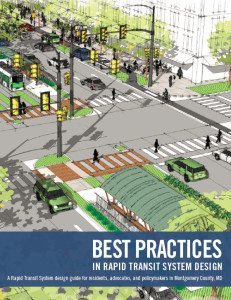FOR IMMEDIATE RELEASE
September 1, 2015
CONTACT
Pete Tomao, Coalition for Smarter Growth
202-675-0016
pete@smartergrowth.net
MONTGOMERY COUNTY, MD — In 2013, the Montgomery County Council unanimously approved a plan for an 81-mile Rapid Transit network based on modern bus rapid transit. Today, appointed citizen task forces are working with county and state staff and consultants to design the network’s first three corridors. But the success of the system depends on getting the details right in order to provide high-quality, frequent, reliable and rapid service.
A new report, “Best Practices in Rapid Transit Design,” provides a roadmap for what’s needed to make Montgomery County’s Rapid Transit System a success.
DOWNLOAD OR VIEW THE FULL REPORT [PDF]
The report, released jointly today by Communities for Transit and the Coalition for Smarter Growth, draws lessons from successful bus rapid transit systems throughout the US and Canada. “As of 2015, there are more than 30 bus rapid transit systems in operation across the US and Canada and more than 25 others in planning. Many have been running since the early 2000s, and have greatly exceeded expectations for ridership and service,” said Pete Tomao, the Coalition for Smarter Growth’s Montgomery County Advocacy Manager. “In Eugene, OR, for example, the Emerald Line has doubled transit ridership in the corridor it serves.”
“Our report is designed to assist the citizen task force members, elected officials and staff in their deliberations,” said Tomao. The report identifies and describes over a dozen features of successful bus rapid transit, including:
- dedicated lanes for vehicles to bypass traffic
- frequent and reliable service
- stops spaced farther apart than local buses
- 10’ general travel lanes
- comfortable stations
- offboard fare collection
- level boarding
- easy, safe access for people walking and bicycling
- real time arrival information.
“BRT systems can produce travel time savings of up to 25% compared to other transit and can move far more people between home, work, school and services along our crowded arterial corridors than can single-occupant vehicles,” said Tomao. “The county’s ability to manage growth and traffic, and to attract the next generation workforce and companies, depends on investing in a well-designed system that attracts passengers because of its quality, efficiency, speed, and reliability.”
“In our research, we’ve found that successful systems around the country consistently share the same features, which we outline in our report and which we hope will be incorporated into Montgomery’s system,” Tomao concluded.
Earlier this year, Montgomery County appointed citizen task forces for each of the network’s first three bus rapid transit corridors: Route 355, Viers Mill Road, and Route 29. The task forces began meeting in Feb 2015 and are split into five groups — MD 355 North, MD 355 South, US29 North, US 29 South, and Veirs Mill Rd. Key decisions include whether to provide dedicated right-of-way, street and station design, fare collection, stop locations and more. The corridor task forces are separate from the Transit Task Force appointed to recommend how to finance the system and who should operate it.
About the Coalition for Smarter Growth
The Coalition for Smarter Growth is the leading organization in the Washington DC region dedicated to making the case for smart growth. Its mission is to promote walkable, inclusive and transit-oriented communities, and the land use and transportation policies and investments needed to make those communities flourish. Learn more at smartergrowth.net.
About Communities for Transit
Communities for Transit (CFT) educates the public on the planned & unanimously-approved Rapid Transit System for Montgomery County, MD. CFT focuses on community outreach to build awareness of the compelling case for rapid transit as an effective response to our unsustainable traffic problems. Learn more at communitiesfortransit.org
###

